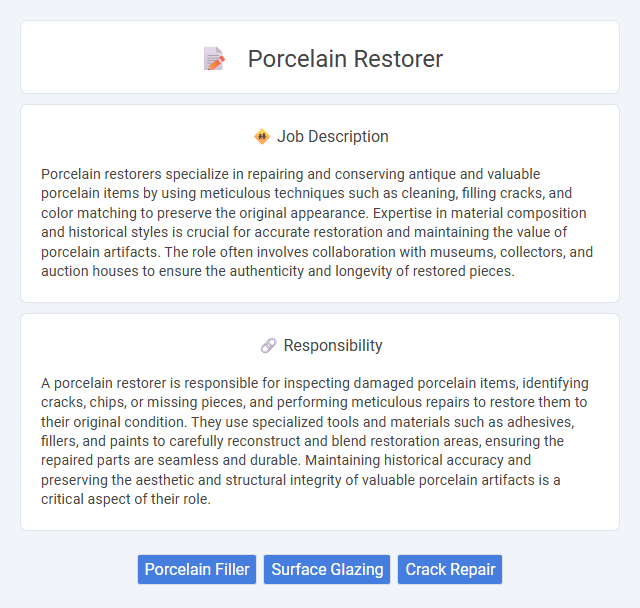
Porcelain restorers specialize in repairing and conserving antique and valuable porcelain items by using meticulous techniques such as cleaning, filling cracks, and color matching to preserve the original appearance. Expertise in material composition and historical styles is crucial for accurate restoration and maintaining the value of porcelain artifacts. The role often involves collaboration with museums, collectors, and auction houses to ensure the authenticity and longevity of restored pieces.
People with steady hands and keen attention to detail are likely to be well-suited for a porcelain restorer job. Those who may struggle with patience or fine motor skills could find the delicate work challenging. Individuals who enjoy art restoration and have a passion for preserving historical items probably have a higher chance of thriving in this role.
Qualification
A porcelain restorer must possess a strong background in fine arts or conservation, often holding a degree in art restoration, chemistry, or a related field. Expertise in materials science, particularly knowledge of ceramic composition and aging processes, is essential for effective restoration and preservation. Precision, attention to detail, and experience with specialized restoration tools and techniques are critical qualifications for maintaining the integrity of valuable porcelain artifacts.
Responsibility
A porcelain restorer is responsible for inspecting damaged porcelain items, identifying cracks, chips, or missing pieces, and performing meticulous repairs to restore them to their original condition. They use specialized tools and materials such as adhesives, fillers, and paints to carefully reconstruct and blend restoration areas, ensuring the repaired parts are seamless and durable. Maintaining historical accuracy and preserving the aesthetic and structural integrity of valuable porcelain artifacts is a critical aspect of their role.
Benefit
Porcelain restorers likely enhance the aesthetic and monetary value of damaged or aged porcelain items, preserving their historical and sentimental significance. The job probably offers the benefit of working with unique artifacts, allowing for the development of specialized skills in art restoration. Engaging in this profession may lead to opportunities in museums, galleries, and private collections, providing a stable and fulfilling career path.
Challenge
Porcelain restorers likely encounter challenges related to matching the original texture and color of delicate ceramics, which requires high precision and expertise. The probability of facing intricate repairs that demand advanced skills and patience is significant due to the fragile nature of porcelain items. Maintaining the structural integrity of valuable pieces while performing restorations presents an ongoing difficulty in this specialized profession.
Career Advancement
Porcelain restorers develop specialized skills in repairing and conserving valuable ceramic artifacts, increasing their expertise through advanced training and certification programs. Progression in this field often leads to senior conservator roles, museum curator positions, or independent consultancy opportunities. Mastery of restoration techniques combined with knowledge of art history and materials science enhances career growth and professional recognition.
Key Terms
Porcelain Filler
Porcelain restorers use specialized porcelain fillers to repair chips, cracks, and surface imperfections on delicate ceramic items, ensuring a seamless blend with the original material. These fillers are carefully matched in color and texture to maintain the porcelain's aesthetic integrity while providing durable, long-lasting repairs. Mastery of porcelain filler application is essential for restoring antique and valuable porcelain pieces without compromising their historical and monetary value.
Surface Glazing
Surface glazing in porcelain restoration involves applying a specialized glass-like coating to repair and enhance the porcelain's finish, restoring its original luster and color depth. This process requires precise handling of glaze materials and controlled firing techniques to ensure durability and seamless integration with the existing surface. Mastery of surface glazing techniques significantly improves the aesthetic and functional qualities of antique or damaged porcelain pieces.
Crack Repair
Porcelain restorers specializing in crack repair utilize advanced adhesives and fillers designed to match the original texture and color of porcelain surfaces. Precise techniques such as UV curing and fine sanding ensure seamless restoration, preserving the item's aesthetic and structural integrity. Mastery of material properties and historical accuracy is crucial for effective long-term crack repair in porcelain artifacts.
 kuljobs.com
kuljobs.com